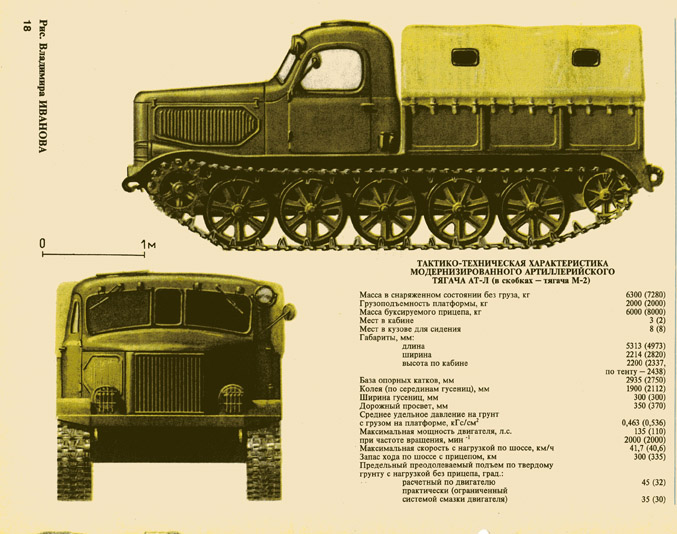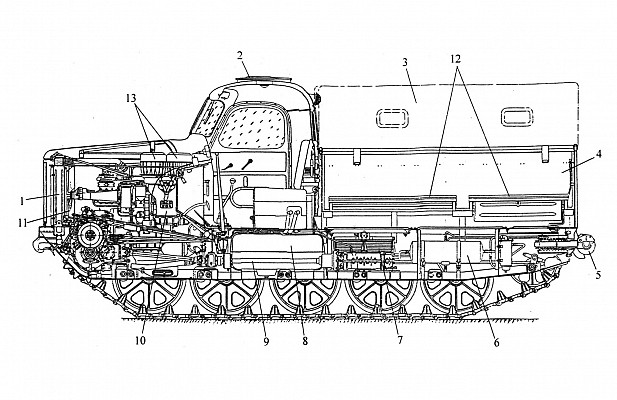AT-L
 Soviet Union
Soviet Union
Artillery Tractor (1949) - c1,500 built
The AT-L (Artilleriskiy Tygach-Legkiy) is a Light artillery tractor, with six small roadwheels without return rollers, which was studied from 1947, accepted in 1949 and produced from 1950. It was unsuccesful and rapidly replaced by the AT-LM. The AT-L and AT-LM being its divisonal level mortar towing vehicles, 160mm and 240mm. The chassis however were declined for many communications and radar platforms. They left front-line searvuce already in the early 1960s, replaced by better 6×6 trucks such as the Ural-375. The AT-L and AT-T were part of the older generation of systems using tank tracks yet fitted with truck cabs and hoods, giving them a unique appearance.
Design of the AT-L

Development
The AT-L light artillery tractor was created in 1947 by the design bureau of the Kharkov Tractor Plant. It was planned to use an existing diesel engine, but since it lacked power, it was decided to resort to a more effective, but expensive and difficult to maintain planetary transmission, without onboard clutches like on the Panther tank, a first in Soviet design. To overcome the meter-long trench asked by the military and increase cross-country ability in deep snow, and lighten the vehicle, designers made the choice to install a welded box-shaped supporting hull instead of a frame.
Field experience showed however that it did not combine well with the original chassis provided six medium size roadwheels due to its design similarity to the Ya-12. It was given the erroneous designation Ya-14 in the West. The mountings of the support rollers could not transfer high loads due to vibrations of the upper track at high speeds, as torsional tension increased for the thin-sheet hull (unlike a tank). The 1947-1948 trials included the testing of 3 protoypes. In 1949 Soviet state trials concluded favourably, with some extra modification, then a production setup in 1950, which went on at KhTZ until 1967.
It was necessary later to redesign the chassis and give it five large-diameter wheels, making it somewhat awkward in appearance but also much heavier. This was done in 1954-1955. From 1957 the HTZ-5A (ATL-5A) was produced in turn and replaced the more conservative Ya-12 also known as the M-2 tractor produced in 1948-1955. Total production numbers is ellusive, no sources could give an answer.
Design in detail

The AT-L was relatively light in terms of tracked artillery tractors, yet with a gross weight of 8 tonnes and 525 kgs and a load capacity of 2 tons, it could pass the 10.5 tonnes mark fully loaded, and way more in the way trucks and tractors were treated by Soviet forces in the early cold war. The general design shows obvious features such as the ladder chassis, on which was installed a stowage bin at the rear, with the flatbed enclosed by a folding panel, and a cabin forward, with three seats, in reality the driver's seat and a bunk alongside, with access doors on either side. The cabin borrowed elements to the ZIL 150s family of trucks but the hood was specific. Indeed it has the same cab as the
ZIS-150 and ZIL-164 trucks, but different front end and grille, similar to the
GAZ-51.
The rear flatbed could also receive folding bunks for eight men, which in towing configuration sat on either side of it, with ammunitions stowed in the middle, albeit supply trucks accompanies them, or other AT-Ls loaded with ammunitions boxes. They could tow up to 6-tons payload, or a trailer of the same weight (typically the ammo carriers had one). The AT-L measured 5,313 meters long for 2,214 meters wide and a 2,2 m tall cabin. The base of support rollers was 2,935 meters, the track, 1,90 meters and ground clearance was 350 mm. The vehicle, was unarmed (apart personal weapons), and unprotected, soft skinned. There was no NBC protection either.
Engine & Perfs

The forward hood housed a 4-cylinder inline YaAZ-204K(V) water-cooled diesel engine, rated for 135 hp at 2000 rpm, a fairly common engine for trucks. It had 108 mm diam. cylinders with a piston stroke of 127 mm (5 inches), a Compression ratio of 16, a displacement of 4,654 cm³. The Cylinder firing order was 1-3-4-2. Initial Power was 110 hp at 2000 rpm for the first YAZ-204, 120 hp at 2000 rpm for the improved YAZ-204A and 135 hp at 2000 rpm for the YAZ-204V with a torque of 500 N*m (51 kgf*m) for the latter.
Maximum torque speed was 1300/min. The engine weighted 800 kg but was easy to removed and maintain. The hood was a classic truck style, with a central spine-hinge opening system.
To speed was 41.9 kmh. It was coupled with a mechanical, Manual, 5-speed gearbox with dry clucth, single-disk with a drive wheel diameter of 52,6 cm for extra grip. The average specific ground pressure was 0.463 kg/cm3. Cruising range on highway with trailer was 300 km initially and climbing ability, loaded without trailer, was a 35° slope. The vehicle had a ground clearance of 35 cm. It could also ford a one meter deep water obstacle. Originally range was just 300 km with a towed ordnance, due to the original two 130 L tanks, later extended to the same plus two 100 L tanks from 1962.
|
| Dimensions: | 5,31 x 2,21 x 2,18 m |
| Gross weight: | 8,525 kgs |
| Suspensions: | LA/LM: 5 roadwheels on torsion bars |
| Crew: | 3 cabin, 8 flatbed |
| Propulsion: | YaAZ-204K 4-cyl. 135 hp 2000 rpm |
| Speed: | 41.9 kph flat |
| Range (on/off road): | 300 trailer, 500 from 1962 |
| Payload: | 2 tons, 6 tons towed |
| Production: | Unknown, c1500 |
Variants

At various times, the AT-L chassis was also equipped with the SNAR-1, SNAR-2 and ARSO-2 (ARSO-2P) artillery reconnaissance radars, the 711 special van, a fire foam lift, a track bridge layer and other special vehicles, for which tractor versions were produced without cargo platforms, towing devices, winches and pneumatic brake systems for towed artillery guns HTZ-23, HTZ-27 and HTZ-39 (since 1957 - HTZ-23A, HTZ-27A and HTZ-39A).
Also, the AT-L could be equipped with OLT or OLT-M bulldozer equipment. It was produced until 1967 in several modifications and earned respect in the army and the national economy. They were widely used for the development of hard-to-reach areas of the USSR.
- AT-L: Original production model made 1950-1954 (6 smaller wheels, 3 return rollers)
- AT-LA:(1955-62) Main production model, 5 large spoke roadwheels.
- AT-LM (1962-67): 2 additional fuel tanks.
Known Operators

Former Syrian AT-L now in Yad a Shiron Museum

Ex Bulgarian vehicle
 Bulgaria
Bulgaria China (presumably)
China (presumably) Hungary
Hungary North Korea (presumably)
North Korea (presumably) Poland
Poland Sri Lanka
Sri Lanka USSR
USSR North Vietnam
North Vietnam
Combat use

The AT-L arrived in numbers into frontline Soviet artillery units from 1953 and were used for a wide range of towed weapon systems, employed instead of regular tactical trucks for road-less Siberia or marchland areas, while also being useful in the rasputitsa and deep snow. Thus, many ended in USSR states in Asia and the Middle East due to the nature of their terrain. They wete used for towing the following:
-160mm M160 breech-loaded heavy mortar.
-240mm M240 breech-loaded 240mm heavy mortar
-122mm D-30 towed howitzer.
-122mm D-74 long range towed howitzer.
-152mm D-20 towed howitzer.
-57mm S-60 anti-aircraft gun.
-85mm KS-12 anti-aircraft gun.
The AT-L was replaced by better tractors in the 1960s and was retored from 1965 onwards from frontline units and converted for other use and by the 1970s, retired, and by the start of 1975, both the AT-L and GT-T formed the basis of the all-terrain fleet of industrial companies in Siberia. Some amazingly still ran at the vbery and of the cold war and in the 1990s. Some also survived into private collections and museums as well, perhaps a small dozen or so.